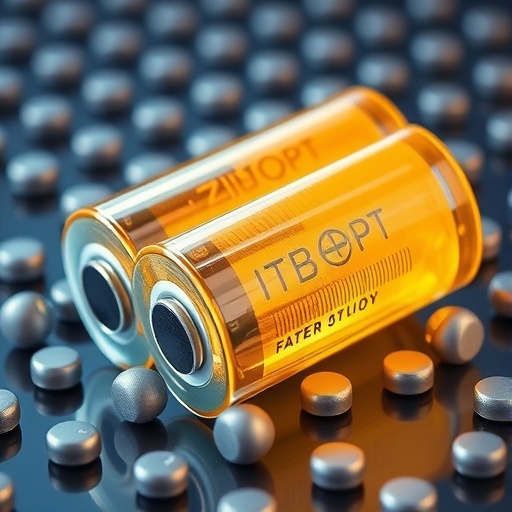Aqueous zinc-ion batteries (ZIBs) have rapidly emerged as a compelling alternative to the ubiquitous lithium-ion batteries (LIBs) fueling much of today’s portable electronics and grid-scale energy storage. While lithium-ion technology remains dominant due to its high energy density and mature manufacturing infrastructure, concerns over safety and cost continue to drive innovation in alternative chemistries. The inherent flammability of the organic electrolytes used in LIBs presents serious safety risks, and raw material scarcity further limits their future scalability. In contrast, ZIBs employing aqueous electrolytes offer a tantalizing proposition: safer operation due to non-flammable water-based electrolytes combined with cost-effectiveness stemming from the natural abundance of zinc. However, technical challenges have slowed their widespread adoption, chiefly related to the instability of zinc anodes during cycling.
To tackle these fundamental issues, research has traditionally focused on engineering protective coatings designed to promote uniform zinc ion flux and suppress dendritic growth on the anode surface. While effective to an extent, conventional protective coatings often introduce new complications. Thick, dense films impede zinc ion transport, increasing ionic resistance and lowering battery performance. Moreover, manufacturing these protective layers tends to be costly and not easily scalable for larger electrode surfaces, limiting practical applications in commercial battery systems.
.adsslot_LrvEIuNBb3{ width:728px !important; height:90px !important; }
@media (max-width:1199px) { .adsslot_LrvEIuNBb3{ width:468px !important; height:60px !important; } }
@media (max-width:767px) { .adsslot_LrvEIuNBb3{ width:320px !important; height:50px !important; } }
ADVERTISEMENT
In an exciting development, a research group led by Associate Professor Woo-Jin Song at Chungnam National University in South Korea has introduced an innovative ultra-thin selective-ion transport layer (SITL) that addresses these limitations head-on. This groundbreaking work, published in the July 2025 edition of the Chemical Engineering Journal, unveils a nanoscale zinc-bonded polyacrylic acid (Zn–PAA) layer engineered for zinc anodes through a novel oxygen plasma treatment process. This approach capitalizes on the synergistic effects of polymer chemistry and surface engineering to produce an effective but incredibly thin ion-selective protective film.
What makes this Zn–PAA coating extraordinary is not only its remarkable thinness — at the nanoscale — but its facile and scalable fabrication method. The coating is applied to zinc anodes using a cost-effective spin-coating technique following oxygen plasma pretreatment, which fine-tunes the adhesion between the PAA polymer and the metallic zinc surface. This contrasts sharply with previous SITLs, which have suffered from complicated, multi-step, and bulky fabrication methodologies unsuitable for mass production on large electrode areas.
Mechanistically, the polyacrylic acid (PAA) component plays a crucial role in stabilizing the zinc anode. PAA’s hydrophilic nature enhances the interaction between the aqueous electrolyte and the zinc surface by promoting uniform ion transfer and distribution. Simultaneously, it forms a barrier that prevents the direct contact of the zinc metal with water, curbing corrosion and suppressing side reactions such as the hydrogen evolution reaction—a major source of irreversible capacity loss and electrolyte decomposition. Furthermore, the PAA protective layer considerably inhibits the formation of passivation layers originating from unwanted reactions with anionic electrolyte components that otherwise degrade the anode surface and exacerbate non-uniform zinc growth.
Yet, PAA alone suffers from solubility issues in aqueous environments, which traditionally undermines its protective functions during long-term cycling. The research team ingeniously addressed this problem by applying oxygen plasma treatment to the zinc anode prior to PAA deposition, a process that chemically modifies the zinc surface, increasing bonding sites and thus greatly enhancing the adhesion and stability of the PAA layer. Subsequent gentle heating induces the formation of zinc-bonded PAA (ZHP), a cross-linked, stable protective polymeric interface that resists dissolution even under harsh ultrasonic agitation in aqueous solutions, signaling robust mechanical and chemical resilience.
Electrochemical testing of the Zn@ZHP anodes revealed remarkable enhancements in cycling performance compared to bare zinc controls. The SITL effectively curtails dendritic growth during repeated plating and stripping processes, encouraging the deposition of uniform zinc crystals preferentially oriented along the (002) crystallographic plane. This crystalline orientation is known for its superior electrochemical activity, contributing to the observed improvements in performance. Impressively, symmetric cell configurations employing Zn@ZHP anodes sustained stable operation exceeding 2200 hours—significantly outlasting conventional zinc anodes under similar conditions.
More practically, full-cell zinc-ion batteries incorporating the ZHP-coated anodes sustained 95% of their initial capacity even after 500 charge-discharge cycles at a current density of 1 A g⁻¹. This level of stability at commercially relevant current rates is a compelling indicator of the technology’s readiness for real-world applications. Extending beyond laboratory-scale coin cells, the team also demonstrated pouch-cell configurations that maintained stable cycling for over 300 cycles under a demanding current density of 10 mA cm⁻², spotlighting the scalability and robustness of the approach.
Dr. Song underscores the broader implications of this advancement: “The enhanced stability of water-based electrolytes makes ZHP-based ZIBs ideal for safety-critical industries such as grid-scale energy storage systems and detection sensors. Furthermore, their low cost and toxicity render these batteries promising candidates for portable electronics and wearable devices.” This multifaceted applicability—from large energy storage grids requiring safe, cost-effective solutions to compact consumer electronics demanding reliability—makes the Zn–PAA nanolayer innovation a pivotal breakthrough.
The synergy of polymer chemistry, surface modification, and scalable engineering highlighted in this research resonates across the broader landscape of energy storage material science. It not only advances the zinc-ion battery domain but offers a blueprint for future innovations aiming to reconcile performance with manufacturability in emerging battery technologies. As demand intensifies for batteries that are safer and environmentally benign, the Zn–PAA nanoscale SITL represents a promising stride toward sustainable, high-performance alternatives capable of redefining how we store and deploy energy in the years to come.
Subject of Research: Not applicable
Article Title: Development of artificial zincophilic polymeric nanolayers on zinc anodes for high-performance zinc batteries
News Publication Date: 1-Jul-2025
Web References: https://doi.org/10.1016/j.cej.2025.162948
References: DOI: 10.1016/j.cej.2025.162948
Keywords
Batteries, Nanotechnology, Energy storage, Materials science, Electrochemistry, Chemical engineering, Electronics, Renewable energy, Biotechnology, Anodes
Tags: alternative battery chemistriesaqueous electrolytes in batteriesartificial polymer nanolayersbattery safety innovationsbattery stability improvementcommercial viability of zinc batteriescycling stability in batteriesEnergy Storage Solutionsnext-gen battery technologyreducing flammability in batterieszinc anode challengeszinc-ion batteries





